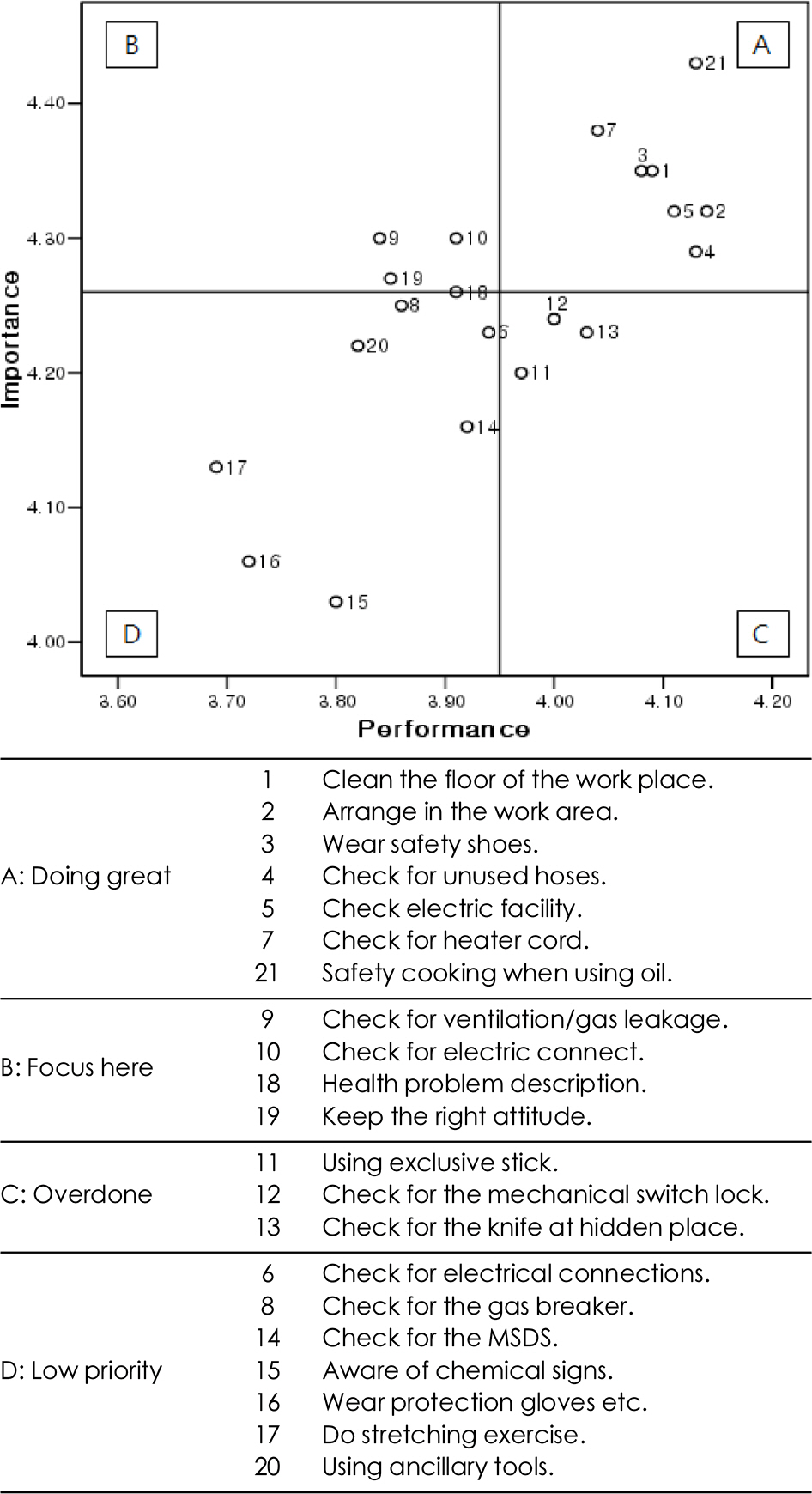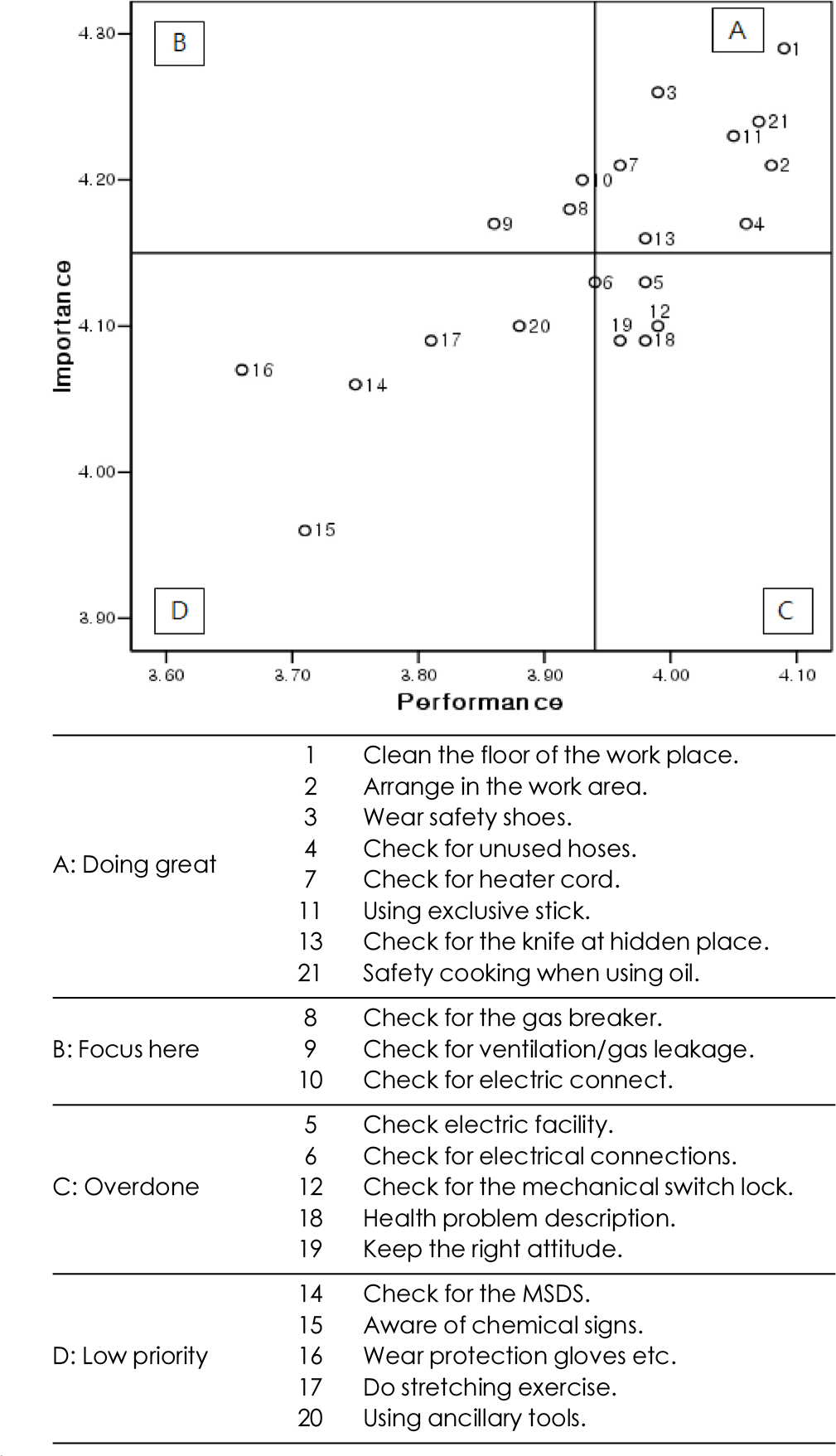J Nutr Health.
2017 Aug;50(4):402-414. 10.4163/jnh.2017.50.4.402.
Comparative analysis of status of safety accidents and importance-performance analysis (IPA) about precautions of safety accidents by employment type of industry foodservices in Jeonbuk area
- Affiliations
-
- 1Major of Nutrition Education, The Graduate School of Education, Chonbuk National University, Jeonju 54896, Korea.
- 2Department of Food Science and Human Nutrition, Chonbuk National University, Jeonju 54896, Korea. jorho@jbnu.ac.kr
- KMID: 2389556
- DOI: http://doi.org/10.4163/jnh.2017.50.4.402
Abstract
- PURPOSE
The purpose of the study was to evaluate the status of safety accidents and importance-performance analysis (IPA) between regular and non-regular employees in industry foodservices.
METHODS
The participants were regular employees (n = 119) and non-regular employees (n = 163) in industry foodservices in the Jeonbuk area. Demographic characteristics, status of safety accidents, safety education, and importance and performance status were assessed using a self-administered questionnaire.
RESULTS
Approximately 66.4% of regular employees and 53.4% of non-regular employees experienced safety accidents (p < 0.05). Types of safety accidents of regular and non-regular employees were mostly burns, and causes were mostly from their own negligence. Approximately 98.3% of regular employees and 95.1% of non-regular employees experienced safety education. Approximately 88.9% of regular employees and 96.8% of non-regular employees received safety education from dietitians. Approximately 41.9% of regular employees and 50.0% of non-regular employees had difficulty applying the contents of safety education due to lack of time during work. As a result of IPA, regular and non-regular employees were aware of the importance of the following and performed them well: "˜Clean the floor of the work place', "˜Arrange in the work area', "˜Wear safety shoes', "˜Check for heater cord', and "˜Safety cooking when using oil'. On the other hand, they were not aware of the importance of the following and performed them insufficiently: "˜Check for the MSDS', "˜Aware of chemical signs', "˜Wear protection gloves etc.', "˜Do stretching exercise', and "˜Using ancillary tools'.
CONCLUSION
Therefore, it is necessary to improve the consciousness of dietitians for effective application of safety education contents, development of contents, especially MSDS, and related things.
Keyword
Figure
Reference
-
References
1. Cho AJ. Study on measures to improve the working condition of irregular workers. Labor Res. 2009; 18:79–113.2. Park JY, Lee NK, Yoon SH, Choi BK, Kim SS. A systematic review of the relationship between non-standard employment and health in South Korea. Health Soc Welf Rev. 2016; 36(3):119–157.3. Statistics Korea. Economically active population survey: job/working style 6th [Internet]. Daejeon: Statistics Korea;2016. [cited 2016 Jul 16]. Available from:. http://kostat.go.kr.4. Statistics Korea. Women's life statistics. [Internet]. Daejeon: Statistics Korea;2017. [cited 2017 May 28]. Available from:. http://kostat.go.kr.5. Jeonju Non-regular Employees Support Center. Working status of employees in school foodservices in Jeonju. Jeonju: Jeonju Nonregular Employees Support Center;2013.6. Rho JO, Choi SA. The working conditions and job satisfaction of the school cafeteria employees according to their employment type in Chonbuk, South Korea. Korean J Hum Ecol. 2010; 19(4):733–744.
Article7. Cho HA, Lee YE, Park EH. Actual conditions and perception of safety accidents by school foodservice employees in Chungbuk. J Korean Soc Food Sci Nutr. 2014; 43(10):1594–1606.
Article8. Cho YJ, Kim HA. Safety accidents and physical fatigue of school foodservice employees. J Korean Soc Food Sci Nutr. 2013; 42(9):1482–1491.
Article9. Park HC. A study for hygiene management of organization meals cupboards using K-means clustering. J Korean Data Anal Soc. 2010; 12(1):241–250.10. Kim SH. Study on the current situation and improvement of safety accident of cooking workers in school meals [dissertation]. Cheongju: Korea National University of Education;2016.11. Shin KH. Importance and implementation analysis of safety accidents status and safety management for employees of school meals in Gyeongbuk area [dissertation]. Daejeon: Chungnam National University;2013.12. Oh SI, Kim OS. Research on actual workplace safety accidents and recognition of workplace safety by employment types of contracted foodservice management company. Korean J Food Nutr. 2011; 24(3):396–405.
Article13. Choi HY, Rho JO. A study on school dietitians'satisfaction with foodservice facilities andutilities in the Chonbuk area of Korea. Korean J Food Nutr. 2007; 20(2):218–225.14. Kim OS, Oh SI. Assessment of accidents occurrence and cuisine employees'awareness of workplace safety in contract foodservice management company. J Korean Diet Assoc. 2010; 16(4):299–317.15. Ministry of Government Legislation (KR). Food sanitation act [Internet]. Sejong: Ministry of Government Legislation;2016. [cited 2016 Aug14]. Available from:. http://www.moleg.go.kr. [cited 2016 Aug14]. Available from:. http://www.moleg.go.kr.16. Choi TS. Influence of a nutrition teacher's servant leadership on cooks'empowerment & organizational commitment. Korean J Culinary Res. 2014; 20(4):239–252.17. Oh ST. Study on the accident of kitchen food service industry employees in accordance with the safety and environment awareness and accident experience. Korean J Culinary Res. 2015; 21(2):85–102.18. Ministry of Government Legislation (KR). Industrial accident compensation insurance act [Internet]. Sejong: Ministry of Government Legislation;2016. [cited 2016 Aug 14]. Available from:. http://www.moleg.go.kr.19. Korea Occupational Safety & Health Agency. Occupational accidents (health-foodservice) [Internet]. Ulsan: Korea Occupational Safety & Health Agency;2016. [cited 2016 Aug10]. Available from:. http://www.kosha.or.kr. from:. http://www.kosha.or.kr.20. Im HJ, Lee YE. Job satisfaction of school foodservice employees in Chungbuk province. Korean J Hum Ecol. 2011; 20(3):651–663.
Article21. Kook SJ, Choi BS, Rho JO. A study on foodservice facilities, utilities, and physical environment in the Chonbuk area of Korea. Korean J Food Nutr. 2009; 22(4):497–507.22. Lee JS, Kim YS. Occupational musculoskeletal disease and stress levelsof restaurant cooks in Gangwon province. Culin Sci Hosp Res. 2017; 23(2):1–10.23. Ministry of Government Legislation (KR). Occupational safety and health act [Internet]. Sejong: Ministry of Government Legislation;2016. [cited 2016 Aug11]. Available from:. http://www.mpleg. go.kr.
- Full Text Links
- Actions
-
Cited
- CITED
-
- Close
- Share
- Similar articles
-
- Comparative analysis on status of events and importance-performance analysis (IPA) between industry and school foodservices
- An educational needs analysis of precautions against of safety accidents for school foodservice employees in the Jeonbuk area using Borich priority formula and the Locus for Focus Model
- A Study on Safety Accidents Occurred for 5 Years at a Welding Material Manufacturing Factory
- Parents' Experience with Infant Safety Accidents and Needs of Safety Education: Content Analysis
- Study on the status of food allergy management and importance-performance analysis about precautions of food allergy in school foodservice according to the school types in Jeonbuk area



